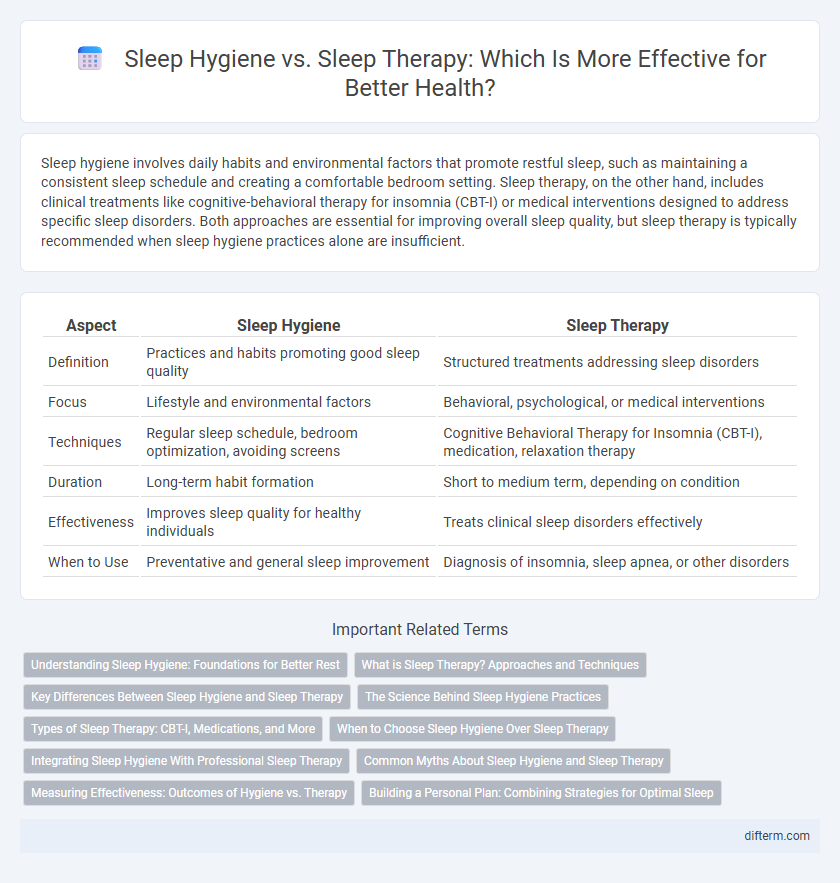Sleep hygiene involves daily habits and environmental factors that promote restful sleep, such as maintaining a consistent sleep schedule and creating a comfortable bedroom setting. Sleep therapy, on the other hand, includes clinical treatments like cognitive-behavioral therapy for insomnia (CBT-I) or medical interventions designed to address specific sleep disorders. Both approaches are essential for improving overall sleep quality, but sleep therapy is typically recommended when sleep hygiene practices alone are insufficient.
Table of Comparison
| Aspect | Sleep Hygiene | Sleep Therapy |
|---|---|---|
| Definition | Practices and habits promoting good sleep quality | Structured treatments addressing sleep disorders |
| Focus | Lifestyle and environmental factors | Behavioral, psychological, or medical interventions |
| Techniques | Regular sleep schedule, bedroom optimization, avoiding screens | Cognitive Behavioral Therapy for Insomnia (CBT-I), medication, relaxation therapy |
| Duration | Long-term habit formation | Short to medium term, depending on condition |
| Effectiveness | Improves sleep quality for healthy individuals | Treats clinical sleep disorders effectively |
| When to Use | Preventative and general sleep improvement | Diagnosis of insomnia, sleep apnea, or other disorders |
Understanding Sleep Hygiene: Foundations for Better Rest
Sleep hygiene involves practices and environmental factors that promote consistent, uninterrupted sleep, such as maintaining a regular sleep schedule, optimizing bedroom conditions, and limiting screen time before bed. It serves as the foundational approach to improving sleep quality and preventing insomnia by addressing lifestyle habits and daily routines. Unlike sleep therapy, which may include cognitive behavioral techniques or medical interventions for sleep disorders, sleep hygiene emphasizes proactive, natural adjustments to support restorative rest.
What is Sleep Therapy? Approaches and Techniques
Sleep therapy involves structured approaches and techniques designed to improve sleep quality and address disorders such as insomnia and sleep apnea. Common methods include cognitive-behavioral therapy for insomnia (CBT-I), relaxation training, and stimulus control, which help modify behaviors and thoughts that interfere with sleep. Medical treatments like continuous positive airway pressure (CPAP) and pharmacotherapy may be integrated for sleep apnea and other clinical conditions.
Key Differences Between Sleep Hygiene and Sleep Therapy
Sleep hygiene involves daily habits and environmental factors that promote consistent, high-quality sleep, such as maintaining a regular sleep schedule and minimizing screen time before bed. Sleep therapy, often conducted under professional guidance, includes targeted interventions like cognitive-behavioral therapy for insomnia (CBT-I) or medical treatments addressing specific sleep disorders. Key differences lie in sleep hygiene's preventive, self-managed approach versus sleep therapy's structured, diagnosis-based strategies aimed at treating underlying sleep problems.
The Science Behind Sleep Hygiene Practices
Sleep hygiene involves consistent habits like maintaining a regular sleep schedule, optimizing bedroom environment, and limiting caffeine intake, which collectively regulate circadian rhythms and enhance sleep quality. Scientific studies show that proper sleep hygiene stabilizes the body's internal clock and improves deep sleep phases essential for memory consolidation and immune function. Sleep therapy, often used for disorders like insomnia, incorporates these principles but also includes cognitive-behavioral techniques to address underlying psychological factors impacting sleep.
Types of Sleep Therapy: CBT-I, Medications, and More
Cognitive Behavioral Therapy for Insomnia (CBT-I) is a highly effective, evidence-based approach targeting the thoughts and behaviors disrupting sleep patterns. Sleep medications, including prescription hypnotics and over-the-counter options, provide short-term relief but carry risks of dependence and side effects. Other therapies such as relaxation techniques, light therapy, and sleep restriction complement sleep hygiene practices to improve overall sleep quality and address underlying insomnia causes.
When to Choose Sleep Hygiene Over Sleep Therapy
Sleep hygiene involves lifestyle and environmental changes to improve sleep quality and is best chosen for mild to moderate sleep difficulties caused by habits or poor sleep environments. Sleep therapy, such as cognitive-behavioral therapy for insomnia (CBT-I), is more appropriate for chronic or severe sleep disorders, including insomnia or sleep apnea. Opt for sleep hygiene first to address manageable issues before progressing to specialized sleep therapy under medical guidance.
Integrating Sleep Hygiene With Professional Sleep Therapy
Integrating sleep hygiene practices, such as maintaining a consistent sleep schedule and creating a restful environment, with professional sleep therapy techniques enhances overall treatment effectiveness for insomnia and other sleep disorders. Cognitive behavioral therapy for insomnia (CBT-I), a leading professional intervention, benefits significantly from patients' adherence to sleep hygiene guidelines, improving sleep quality and duration. Combining these approaches addresses both behavioral and physiological aspects, promoting sustainable, long-term sleep health.
Common Myths About Sleep Hygiene and Sleep Therapy
Common myths about sleep hygiene include the belief that rigid bedtime rituals guarantee restful sleep, while in reality, individual variability affects effectiveness. Sleep therapy misconceptions often assume it is solely for severe sleep disorders, ignoring its benefits for general sleep improvement through cognitive-behavioral techniques. Understanding these nuances helps optimize sleep quality by combining personalized hygiene practices with targeted therapeutic interventions.
Measuring Effectiveness: Outcomes of Hygiene vs. Therapy
Measuring the effectiveness of sleep hygiene versus sleep therapy involves assessing improvements in sleep quality, duration, and latency through objective tools like polysomnography and subjective sleep diaries. Sleep hygiene interventions often yield moderate enhancements in sleep patterns by promoting consistent routines and reducing environmental disruptions, while sleep therapy, particularly cognitive-behavioral therapy for insomnia (CBT-I), demonstrates higher efficacy in treating chronic sleep disorders with sustained symptom reduction. Comparative studies reveal that therapy produces more significant long-term improvements in sleep efficiency and decreases in sleep-related daytime impairments compared to hygiene alone.
Building a Personal Plan: Combining Strategies for Optimal Sleep
Building a personal sleep plan involves integrating sleep hygiene practices--like maintaining a consistent sleep schedule, creating a restful environment, and limiting screen time before bed--with tailored sleep therapy methods such as cognitive-behavioral therapy for insomnia (CBT-I) and relaxation techniques. Tracking sleep patterns through diaries or apps enables adjustments to optimize sleep quality and duration. Combining these strategies helps address both behavioral and physiological factors to achieve sustained, restorative sleep.
Sleep hygiene vs Sleep therapy Infographic

 difterm.com
difterm.com